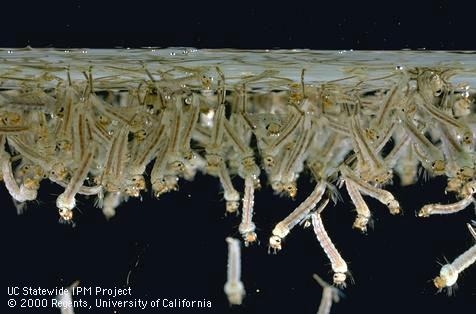![Figure 1. A well-managed water garden, such as this one, keeps mosquito numbers in check. [Photo by M.L. Flint] Figure 1. A well-managed water garden, such as this one, keeps mosquito numbers in check. [Photo by M.L. Flint]](http://ucanr.edu/blogs/UCIPMurbanpests/blogfiles/23032.jpg)
Many gardeners are adding fountains, ponds, and other water features to their landscapes. Water gardens (Figure 1) are beautiful and calming, but, if not managed properly, can add an unpleasant element to the landscape—mosquitoes. How can you manage water features to prevent mosquito infestations?
First, it is important to understand mosquito biology. Mosquitoes are small flies that lay their eggs in, on, or near stagnant water. The larvae, or wigglers, (Figure 2) that hatch from the eggs live in water and feed on organic debris until they transform into a motile pupa, or tumbler, and finally into the familiar adults. This process, from egg to adult, requires as little as one week when conditions are favorable. Emerging females must mate and ingest blood in order to produce new eggs.

Water features in the landscape will invariably attract adult mosquitoes, but attempting to control them or prevent their egg laying is difficult. Larvae are easier to manage, since they are concentrated in known areas, don't yet bite, and can't fly away. Larvae prefer shallow water that is less than 24 inches deep, so suggest to your customers that they install water features that are deeper than 2 feet. Ponds or features that provide a steep slope or have vertical walls that quickly drop off into deep water will also be less favorable to mosquitoes. Suggest adding a fountain, waterfall, or other device that increases water circulation and reduces the stagnation that allows mosquitoes to breed.
Remove excess vegetation and organic debris that provide mosquito larvae with food, shelter from the sun, and hiding places from predators. For larger ponds, a pond skimmer will help keep mosquitoes and the algae that favors them under control. For customers with smaller ponds, consider stocking inexpensive pond skimmer nets. If fertilization is required, use pond spikes designed to prevent algae blooms.
In natural environments, bacteria, nematodes, other insects, crustaceans, and fish often keep numbers of mosquito larvae low. Encourage customers to conserve predators such as dragonflies and backswimmers (Figure 3), which may have colonized ponds, by avoiding broad-spectrum insecticides and to consider introducing fish. County vector control services may provide free mosquito fish (Figure 4), voracious consumers of mosquito larvae and pupae. Never release mosquito fish into natural water bodies, since these fish aren't native to California and can disrupt ecosystems.
Although these measures will prevent problems in most cases, mosquito larvae may still develop in some ponds. In gardens with lots of plants growing in still water, it may be impossible to keep mosquitoes from breeding. Advise customers to regularly check their water features for larvae, which periodically come to the surface to breathe through abdominal siphons (Figure 4). Watch for the larvae's characteristic wriggling movement, or use fine dip nets to monitor for larvae. It is important to act quickly to kill mosquitoes when they are small, easiest to manage, and before they become adults and start biting.
Be sure your store carries larvicides specially designed for use against mosquitoes in water. Larvicides containing spores or metabolites of the bacterium Bacillus thuringiensis israelensis (Bti) (e.g., Mosquito Dunks, Mosquito Bits, Microbe-Lift, and other products) act as stomach poisons when ingested, killing larvae within a few days. Bti affects only fly larvae, so it won't harm predatory insects living in the pond or water feature. Another effective larvicide is the insect growth regulator (IGR) methoprene (e.g., Pre-strike Torpedos). IGRs interfere with larval molting and also take a few days to kill, but they have a broader spectrum of activity, affecting most juvenile insects and other arthropods that might be in the pond. Both Bti and methoprene are available as granules or pellets, remain effective for about a month, and as with all pesticides, should be used only according to label directions.
For more information about mosquitoes, visit http://www.ipm.ucdavis.edu/PMG/PESTNOTES/mosquitoes.html .
This article was originally published in the June 2013 issue of the UC IPM Retail Nursery & Garden Center IPM News. See this and other articles at http://www.ipm.ucdavis.edu/RETAIL/retail-newsletter.html.
![Figure 3. Backswimmers are predators of mosquito larvae in natural aquatic habitats. [Photo by J.K. Clark] Figure 3. Backswimmers are predators of mosquito larvae in natural aquatic habitats. [Photo by J.K. Clark]](http://ucanr.edu/blogs/UCIPMurbanpests/blogfiles/23034.jpg)
![Figure 4. The mosquito fish, Gambusia affinis, and four mosquito larvae with breathing siphons. [Photo by J.K. Clark] Figure 4. The mosquito fish, Gambusia affinis, and four mosquito larvae with breathing siphons. [Photo by J.K. Clark]](http://ucanr.edu/blogs/UCIPMurbanpests/blogfiles/23035.jpg)